A refresher course on LP-gas systems, from DOT cylinders and ASME tanks to OPD valves and TW stamps
In the RV world, LP-gas is a main source of energy to power generators and fuel appliances necessary for comfort heating, cooking and refrigeration. “LP” is an abbreviation for liquefied petroleum. The terms “LP-gas” and “LPG” are widely used to describe the hydrocarbons propane and butane, or a mixture of the two. The compounds are similar, but propane is a better fuel source at lower temperatures, making it the choice for use in RVs. Propane is likely to contain small amounts of other hydrocarbons such as butane, propylene and butylene.
LP-gas is produced by processing natural gas and refining crude oil. When LP-gas is placed under modest pressure, it liquefies and can be stored in portable cylinders used on camping trailers and truck campers and in frame-mounted tanks for motorhomes. LP-gas is colorless and odorless. For safety reasons, the chemical ethanethiol, commonly called ethyl mercaptan, is added to provide a distinct odor in the event of a leak.
LP-gas cylinders used on trailers and truck campers are different from the LP-gas tanks used on motorhomes. A DOT cylinder is a removable portable container like those that supply propane for barbecue grills and is built to U.S. Department of Transportation specifications. An ASME tank for motorhomes is a permanently mounted storage container approved by the American Society of Mechanical Engineers.
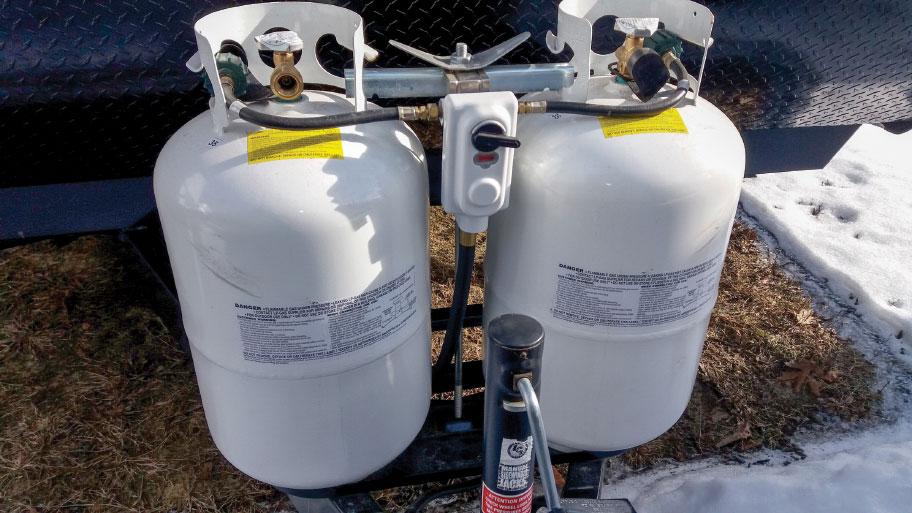
Automatic-changeover regulators maintain pressure while switching from empty to full cylinders and allow one cylinder to be removed for filling.
DOT cylinders come in different shapes and sizes, and are referred to by the amount of propane they can hold, measured in pounds. Cylinders used on trailers are usually 20 or 30 pounds, but some large fifth-wheels have 40-pound cylinders. A 20-pound cylinder holds 4.7 gallons, a 30-pound cylinder holds 7 gallons, and a 40-pound cylinder holds 9.4 gallons, although common capacity terminology for these is 5, 7 and 10 gallons. ASME tanks also vary in size and capacity.
Propane stored in cylinders is in a liquid state. Once the cylinder is connected to the RV’s LP-gas system and the service valve on top is opened, the liquid propane boils and exits the cylinder as a vapor in much the same way that boiling water converts to steam (water vapor). The trailer’s piping is then pressurized with propane vapor. Propane boils at minus-44 degrees Fahrenheit at sea level, while butane boils at 30 degrees, which is why propane is the preferred fuel source.
DOT cylinders used in RVs are required to have an overfill-prevention device (OPD). OPD-equipped cylinders have a triangular-shaped handwheel on the service valve. These valves prevent the cylinders from being filled to more than 80 percent of their capacity. The remaining 20 percent holds propane vapor and allows for thermal expansion.
Like water, propane expands when heated. However, the volume of expansion of propane is almost 17 times that of water, given the same temperature increase. When propane expands, pressure inside the cylinder increases. Without room for expansion, pressure in the cylinder could reach dangerously high levels or force liquid propane into the system. ASME tanks have the same overfill protection.
Pressure in a DOT cylinder or ASME tank is mainly determined by the volume of liquid propane and temperature. These containers are built to withstand the pressures normally associated with propane, but if excessive pressure develops, a relief valve opens to allow the vapor to vent. DOT cylinders should not be stored in enclosed places, such as garages and vehicles, where vented vapor can accumulate and possibly ignite. Cylinders in fifth-wheels are generally stored in compartments that have the required venting for vapor to escape.
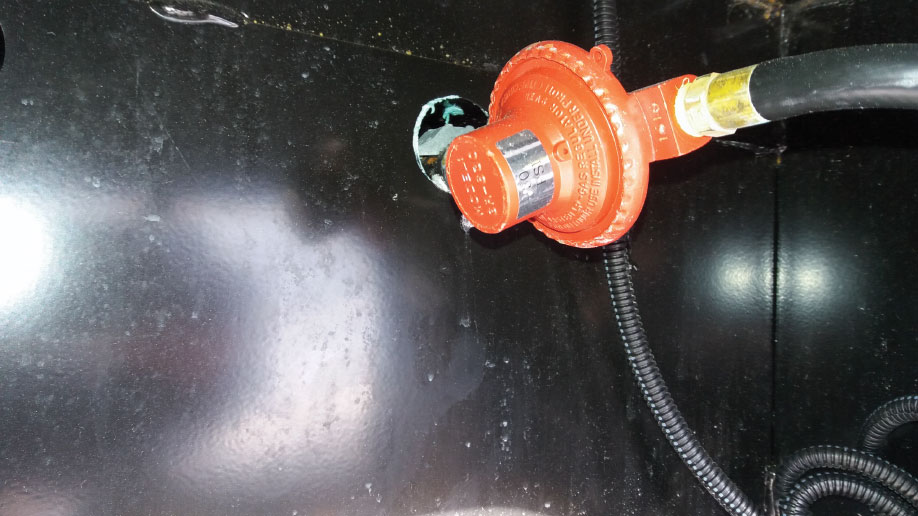
Step-down regulators reduce pressure, preventing condensation when a long hose connects cylinders housed in separate compartments, a common setup on fifth-wheels.
When propane boils into a vapor, it expands to 270 times its volume as a liquid. Since there is not enough volume in a cylinder or tank to allow for full expansion, the vapor begins to compress and raise the pressure. When a liquid is under pressure, its boiling point increases. The pressure will rise until it is sufficient to prevent the liquid propane from boiling any further. When propane is needed for an appliance to ignite, pressure in the system drops and the propane begins to boil.
New DOT cylinders and ASME tanks that have never been filled with propane must be purged of air. This process is done at filling stations by qualified personnel. Purging results in air inside the container being forced out by propane vapor. Because air is more difficult to compress than propane vapor, an increase in temperature with air in the expansion volume of the container will result in higher pressure than normal. Excessive pressure could cause the pressure-relief valve to vent the vapor.
Air inside a cylinder or tank makes filling to its capacity difficult. Contaminants might be present in the air and should be removed. Moisture could freeze within the system and cause the container to rust from the inside out.
Regulations prevent filling DOT cylinders that aren’t outfitted with OPD valves. Service valves in older cylinders with a round or pinwheel-style handwheel can be updated with OPD valves by certified technicians. Cylinders expire 10 years after the date of manufacture but can be recertified for five-year periods. The date of manufacture is engraved in the cylinder collar. Additional information is also stamped on the collar, such as the empty cylinder weight.
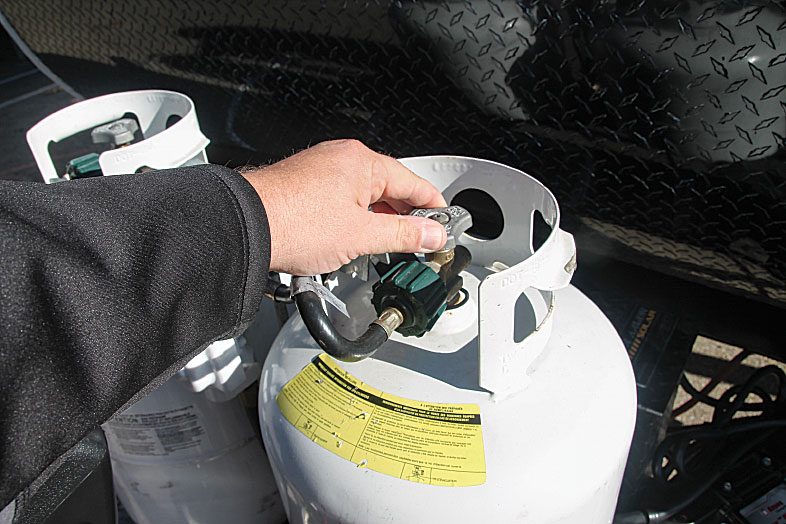
Service valves on DOT cylinders have three-sided handwheels and OPD safety devices that prevent overfilling.
DOT cylinders are connected to the RV’s LP-gas system by high-pressure hoses often called pigtails because older hoses were made of coiled copper that resembled a pig’s tail. The flexible hoses are connected to the OPD valve with an ACME nut. ACME nuts use right-handed threads to screw onto the OPD valve and are meant to be tightened by hand only. OPD valves have a built-in safety device that prevents the flow of propane until the ACME nut is screwed on securely. This prevents vapor from escaping if the valve is opened before the cylinder is connected.
ACME nuts contain two safety devices. An excess-flow valve limits the flow of propane to approximately 10 percent of maximum in the event of a leak in the system. When the OPD valve is opened, a clicking noise is heard from the ACME nut. This indicates the temporary closing of the excess-flow valve, allowing only a small amount of propane vapor to enter the system. Once pressure builds up, confirming that no leaks are present, a second clicking noise indicates that the excess-flow valve has opened, allowing full flow. A thermal shutoff is also included in the ACME nut, which stops the flow of propane in the event of a fire.
After passing through the high-pressure hose, propane vapor enters the pressure regulator. RVs are required to have a two-stage regulator. The first stage drops the vapor pressure to approximately 10 to 15 psi, and the second stage further reduces operating pressure to 11 inches of water column. The change from psi to inches of water column is helpful because the latter value is a much smaller unit of measure. It is similar to switching from gallons to ounces.
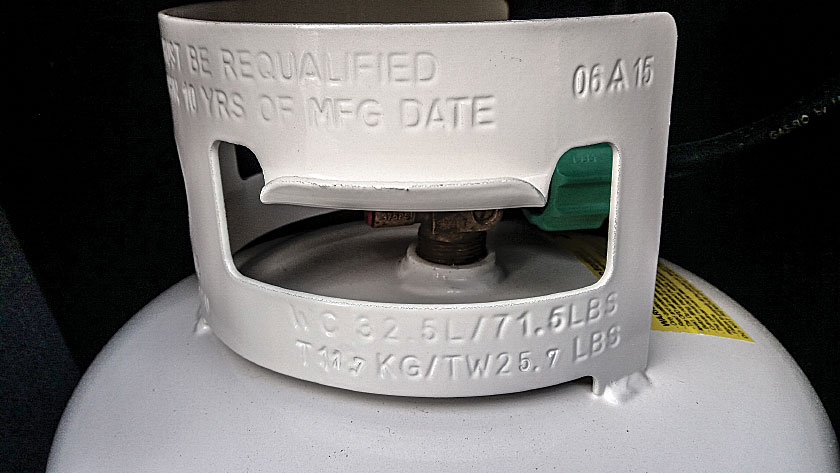
Cylinders must be replaced or recertified 10 years after the date of manufacture, marked as June 2015 on the collar of this cylinder.
Propane regulators use flexible diaphragms connected to a valve to control pressure. Regulator diaphragms require a vented air space to function properly. These vents must be pointed downward, within 45 degrees of vertical, to allow condensation to drain and prevent debris from restricting airflow. A cover should be used to protect propane regulators on cylinders that are not housed in compartments or other enclosures.
The pressure output of a two-stage regulator is adjustable and should be checked periodically by a qualified technician using a device called a manometer. Two tests are done to determine if a regulator is performing within specifications. The first verifies the operating pressure of the system, which is the pressure output of the regulator at approximately 50 percent of the maximum flow rate of the regulator. The operating pressure should be 11 inches of water column. If the reading is not correct, the technician can attempt to adjust the pressure regulator. If the regulator can’t be adjusted to the proper pressure, it must be replaced.
A second test is performed to determine operating pressure with no propane flow. This is referred to as the lockout test. When no propane is flowing through the pressure regulator, the pressure reading normally increases by about 1 inch of water column, giving a lockout pressure reading of 12 inches of water column. However, as long as the lockout pressure doesn’t rise above 14 inches of water column, the regulator is considered good.
A manometer can also be used to check for leaks. After connecting the device, the technician shuts off the propane valve or valves and bleeds the system pressure down to 8 inches of water column. The pressure should remain the same for three minutes. A pressure drop indicates the system has a leak that must be repaired.
Some smaller travel trailers and slide-in campers come with a single DOT cylinder, often with a 5-gallon capacity (technically, 4.7 gallons). Larger trailers are equipped with two cylinders connected to a single regulator. RVs with dual cylinders are equipped with an automatic-changeover regulator that draws propane from one cylinder and automatically switches to the other when the first cylinder is empty.
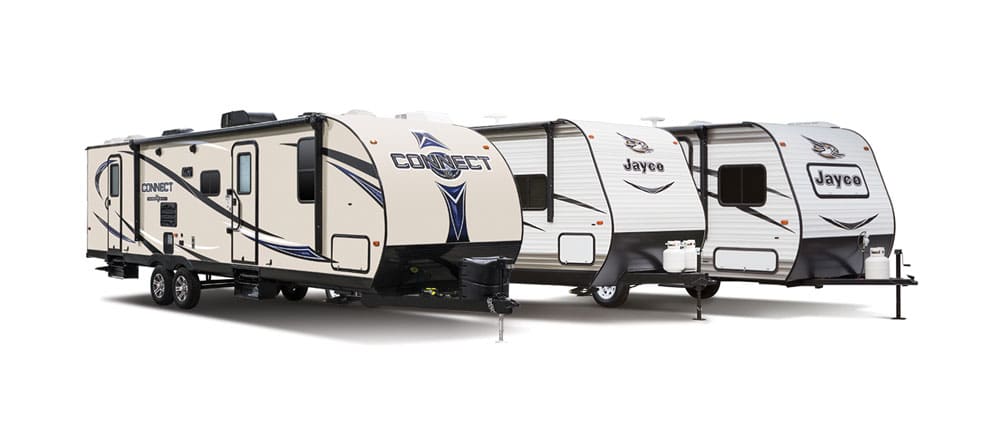
Some trailers come with a tray on the A-frame that holds one or two cylinders, while others provide an enclosure that shields cylinders from dirt, debris and weather but allows access to the automatic-changeover regulator. Fifth-wheels typically house cylinders in vented storage compartments.
Automatic-changeover regulators come in different styles but function similarly. A lever or button on the regulator is used to choose which cylinder will be drawn from first. Both cylinder valves must be open for the automatic changeover to occur. For example, if the left cylinder is used first, a sight glass will show a green flag until it is empty, at which time a red flag will become visible. At this point, the right cylinder will start servicing the system, the lever on the regulator can be turned or the button pushed, and the empty cylinder can be removed safely for filling.
Fifth-wheels typically split the pair of cylinders in two compartments on either side of the trailer. The two-stage regulator is installed in one of the compartments, requiring a flexible high-pressure hose to supply propane from the remote cylinder. If the hose is 60 inches or longer, a step-down single-stage regulator is required with a pressure rating of no more than 30 psi. With a long hose under full pressure, it is possible for the vapor to condense into liquid. This liquid could accumulate in the lowest point of the hose and cause a drop in pressure. Lower pressure from the step-down regulator prevents condensation from occurring.
Some LP-gas systems have an outside quick-connect fitting that is attached to exterior piping. Quick-connects allow appliances such as propane grills and cooktops in some outside kitchens to be instantly connected to the system. Quick-connects can be added to RVs, but they must be approved for use with LP-gas. To prevent propane flow when the appliance is not connected, they must also have an integral shut-off valve or a manual shut-off within reach of the quick-connect. A cap should be used to prevent debris and moisture from entering the fitting when not connected.
Today’s LP-gas systems are virtually essential to the RV lifestyle, although some electric-only RVs are available for those who prefer to avoid the use of propane. By understanding how your system works and maintaining it properly, you can safely enjoy all the comforts of home while on the road and at your favorite camping destinations.
Running on Empty?
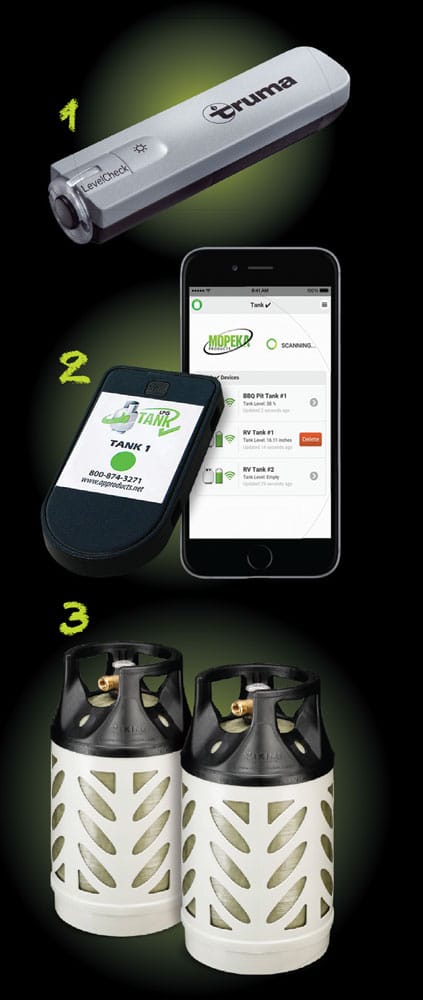
(1) Truma’s hand-held LevelCheck uses ultrasound to determine liquid-propane levels. (2) Mopeka’s LPG TankCheck has sensors that measure propane levels and transmit them to a mobile app or optional monitor. (3) Viking’s composite containers are about 50 percent lighter than standard steel cylinders and have translucent sides for viewing the propane level.
Determining how much liquid propane is in a cylinder can be problematic. Since DOT cylinders are not fitted with gauges, RVers resort to various ways to determine how much propane is left inside.
One tried-and-true method is to weigh it, although simply removing the cylinder and feeling how heavy it is can give an idea of how much propane it contains. Scales are available that hook to the cylinder’s collar and display the weight when the cylinder is lifted, but a bathroom scale will also work.
The empty cylinder weight, or tare weight, is engraved on the cylinder’s collar. It begins with the letters “TW,” followed by the weight in pounds. Subtracting the tare weight from the weight provided by the scale gives the weight of the propane. Divide the propane weight by 4.2 (the weight of 1 gallon of propane), and the result is the number of gallons in the cylinder.
Don’t forget that 20-, 30- and 40-pound cylinders hold 4.7, 7 and 9.4 gallons, respectively, not the looser 5-, 7- and 10-gallon terminology often used by RVers.
Weighing gives an accurate result but can be time-consuming and cumbersome, especially when removing a large cylinder from a fifth-wheel compartment. A gauge can be inserted between the OPD valve and the high-pressure line’s ACME nut, but these level indicators are sensitive to changes in temperature and can be inaccurate. Another type of gauge mounts magnetically on the side of the cylinder but shows the level only when LP-gas is in use and is more commonly found on cylinders for barbecue grills.
Electronic sensors include Truma’s LevelCheck, a hand-held ultrasound device that is pressed against the side of a cylinder and indicates propane level with a green LED and a high-pitched beep. Mopeka’s LPG TankCheck comes with sensors that attach to the bottom of cylinders and use sonar to detect propane levels and Bluetooth to transmit them to an optional display monitor or a mobile app on a smartphone or tablet.
In the absence of a scale or sensor, pouring a small quantity of hot water down the side of the cylinder gives an approximate level. Run your hand down the side of the cylinder where you poured the hot water, and when you feel a cold spot, that’s the approximate fuel level. The propane liquid absorbs the water’s heat from the metal tank, and that gives a rough idea of its level inside. You may also see a place on the cylinder where the hot water is evaporating differently, and that’s another clue to the level.
A final way to assess propane level is to see it. While that’s not possible with steel cylinders, translucent containers made by Viking Cylinders provide a clear view. The DOT-approved fiberglass-composite cylinders are about half the weight of steel ones but differ somewhat in capacity, with the most popular sizes for RVing holding 5.24 and 7.38 gallons.
Let’s Talk Safety
Monitoring and maintaining the LP-gas system is a critical part of RV ownership. Because these systems have an element of risk — the possibility of flammable gas leakage — no discussion would be complete without talking about safety.
The systems have mandatory safety features such as overfill-prevention valves, thermal shut-offs, excess-flow valves and step-down regulators. Other essential safety equipment includes fire extinguishers, emergency exits, and detectors for smoke, carbon-monoxide and propane.
Propane detectors are required in RVs and should be installed in older trailers that do not have them. Mounted at floor level because propane vapors are heavier than air and settle to the floor, the detectors sound an alarm when they sense propane vapor. They have an expiration date stamped on them by the manufacturer and generally have a life expectancy of five to seven years.
Propane detectors are powered by the trailer’s 12-volt DC system, and low voltage caused by a discharged battery or faulty electrical converter can lead to false alarms. Hydrocarbons present in household items such as hair spray and cleaning products can also cause propane detectors to go off. Unfortunately, these false alarms cause some owners to become desensitized. Never assume that a leak-detector alarm is false simply because the distinctive odor of gas isn’t present.
RVers must take proper steps to protect against LP-gas accidents. Read and follow all warning decals that came with the RV. When filling a tow vehicle with fuel, all pilot lights and appliances with electronic ignition should be shut off because the spark from an electronic ignitor could cause fuel vapors to ignite. Test detectors regularly and replace them when they expire. Never remove the fuse for a propane detector due to false alarms.


